

Partner Eula Seeley Garrison
Queer Places:
Château Élysée, 5930 Franklin Ave, Los Angeles, CA 90028
189 Long Ridge Rd, Danbury, CT 06810
 Rachel
Crothers (December 12, 1878 – July 5, 1958) was an American playwright and
theater director known for her well-crafted plays that often dealt with
feminist themes. Among theater historians, she is generally recognized as "the
most successful and prolific woman dramatist writing in the first part of the
twentieth century."[1] One
of her most famous plays was Susan and God (1937), which was made into a
film by MGM in 1940 starring Joan
Crawford and Fredric
March.
Rachel
Crothers (December 12, 1878 – July 5, 1958) was an American playwright and
theater director known for her well-crafted plays that often dealt with
feminist themes. Among theater historians, she is generally recognized as "the
most successful and prolific woman dramatist writing in the first part of the
twentieth century."[1] One
of her most famous plays was Susan and God (1937), which was made into a
film by MGM in 1940 starring Joan
Crawford and Fredric
March.
Crothers was born on December 12, 1878 in Bloomington, Illinois, to Dr. Eli Kirk Crothers and Dr. Marie Louise de Pew.[2] Crothers' mother, an independent-minded woman whose father had been friends with Abraham Lincoln, went to medical school at forty and became one of the first woman physicians in Illinois, encountering and eventually overcoming much opposition to her practice in Bloomington.[3] Though her parents were religious and conservative, with no particular interest in theater, issues of money, equality, risk-taking, and a woman's place in the world were a part of Crothers' life from her earliest years. The family intended that their daughters should be educated, and Crothers graduated from Illinois State University High School in 1891, at the precocious age of thirteen. The following year, she attended the New England School of Dramatic Instruction in Boston, where her passion for the stage was nurtured. Her hopes of moving to New York to seek a career in theater were opposed by her parents, who insisted she return home to Illinois. Her interest in acting continued even there, however, and she was a founding member of the Bloomington Dramatic Club. (Her taste in plays was rather advanced for the time: Ibsen's still-scandalous A Doll's House was one of her suggestions for a Club production.[4]) By the age of nineteen, five years after her father's death, Crothers was allowed to realize her dream and move on her own to New York. "I knew no one in New York," she later recalled, "but I had heard of David Belasco and Daniel Frohman, and they were kind enough to answer my letters."[5] That was encouragement enough and, though the famous producers' help ended there, she left Bloomington for Manhattan (with the financial backing of her mother), enrolled in acting classes, and found small parts in stock and touring companies. By 1899, Crothers was writing her own one-act plays, and over the next few years, as these plays received showcase productions and good notices, she gained a reputation as a young dramatist of serious potential with an interest in the Ibsen-style "social problem drama." Her big break came in 1906, at the age of twenty-eight, when her first full-length play, The Three of Us, was produced and enjoyed a 277-performance run at the Madison Square Theatre in New York City. The play received its London premiere at Terry's Theatre on June 10, 1908, with Fannie Ward playing the leading role.[6]
Crothers was part of an "old girls' network" of theater professionals that took shape in the 1920s. Asked by Djuna Barnes in a 1931 interview about how she had been able to make a successful career in a male-dominated field, Crothers answered: "For a woman, it is best to look to women for help; women are more daring, they are glad to take the most extraordinary chances....I think I should have been longer about my destiny if I had to battle with men alone."[15] Actresses were especially appreciative of the strong roles she created for them, and leading parts in her plays were performed by Ethel Barrymore, Estelle Winwood, Katharine Cornell, Tallulah Bankhead, and Gertrude Lawrence, among others.
Crothers was a major name in the Broadway theater world. Her commercial record was erratic—hits and flops, equally mixed—but she was a productive and respected writer with a considerable body of work to her name by the time she was middle-aged. Throughout her career, Rachel Crothers lived in a New York apartment on Park Avenue and, later, in a Connecticut farmhouse, shared with her companion, Eula Seeley Garrison, where she died on July 5, 1958.[7] Garrison's daughter, Angeline G. Hoagland, who occasionally performed secretarial work for Crothers, was the sole beneficiary of Crothers' estate. Angeline G. Hoagland donated Crothers’ materials to the Museum of the City of New York.
My published books: